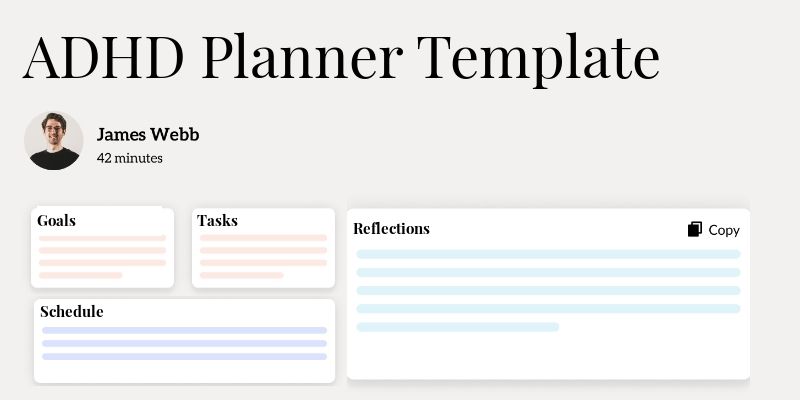
ADHD Planner Template
Welcome! If you're finding it challenging to keep track of tasks and commitments due to ADHD, you're not alone. Many individuals face difficulties organizing their thoughts and activities. This article is here to help by providing expert insights on using an ADHD planner template. Let's explore how this tool can transform your daily organization.
What Is an ADHD Planner Template?
An ADHD planner template is a customized tool designed to assist individuals with ADHD in organizing their daily activities and priorities. It acts as a guide to help track tasks, appointments, and goals, ultimately improving productivity.
This template offers structured formats that cater to the unique challenges faced by individuals with ADHD, enabling them to manage their time effectively and reduce stress.
Key Components of an ADHD Planner Template
The ADHD planner template typically includes several key components that tailor to the needs of the user:
- Daily Task List: A section to record and prioritize daily responsibilities.
- Appointments and Meetings: Space to note down scheduled events and deadlines.
- Priority Levels: Tools for setting task importance levels to maintain focus.
- Notes and Ideas: An area for jotting down thoughts that might otherwise be forgotten.
- Reflection Section: Provides a space for daily or weekly reflections to track progress and adjustments.

How to Use an ADHD Planner Template: Step-by-Step Process
Step 1: Select Your Template
Choose a planner template that aligns with your personal needs and preferences.
Step 2: Customize the Sections
Fill in the template sections with relevant tasks, meetings, and notes. Tailor it to your specific routine.
Step 3: Set Priorities
Identify high‑priority tasks and mark them using the designated priority level in the template.
Step 4: Review and Reflect
End each day by reviewing completed tasks and reflecting on any adjustments needed.
Benefits of an ADHD Planner
Benefit | Description |
|---|---|
Improved Focus | Helps eliminate distractions by providing a clear overview of the day's tasks. |
Enhanced Productivity | Aids in organizing time efficiently, leading to better productivity. |
Reduced Stress | Provides structure, reducing the anxiety often associated with task overload. |
Better Time Management | Encourages planning ahead and managing appointments effectively. |
Stakeholders in ADHD Planner Templates
The effectiveness of an ADHD planner template profoundly impacts multiple stakeholders involved with individuals who have ADHD.
- Individuals with ADHD: John, a graphic designer, uses the planner to keep track of project deadlines, significantly boosting his performance.
- Therapists: Dr. Emily advises her patients on how to adopt planners as part of therapy, marking improvements in treatment outcomes.
- Family Members: Sarah uses the template to assist her son in establishing routine, resulting in a more organized household.
- Employers: Tom uses this planner to help his employees manage tasks better, leading to a smoother workflow.
Example of an ADHD Planner PDF
Here’s a snippet demonstrating how an ADHD planner PDF might look, with interactive sections to meet diverse needs.
Real-World Use Cases: Practical Impact of the ADHD Planner Template
The real‑world benefits of ADHD planner templates can be seen in various scenarios, enhancing productivity and organization.
- Imagine Alex, a high school student, who uses his planner to juggle classes and extracurricular activities, leading to improved grades and less stress.
- Consider Lisa, a manager who keeps her team on track with shared goals using planner templates, thereby boosting team efficiency.
- Picture Sam, a freelance writer, who organizes his assignments and deadlines within his planner, allowing him to take on more work without feeling overwhelmed.
Conclusion
In conclusion, an ADHD planner template empowers individuals to take charge of their schedules, improving focus, productivity, and stress management. By choosing and customizing the right template, users can better navigate their daily responsibilities, making life a little bit easier.
Disclaimer: This article is for informational purposes only and does not constitute legal or medical advice. Always consult professional guidelines and regulatory bodies for specific compliance requirements.

Dr. Danni Steimberg
Dr. Danni Steimberg is a pediatrician at Schneider Children’s Medical Center with extensive experience in patient care, medical education, and healthcare innovation. He earned his MD from Semmelweis University and has worked at Kaplan Medical Center and Sheba Medical Center.
An ADHD planner should do more than list tasks ‑ it must capture ideas as they surface, convert them into ranked actions, and provide rapid feedback on progress. The Ping‑Prioritize‑Pulse flow keeps pages uncluttered while delivering dopamine‑friendly wins that sustain focus.
- Ping for Capture: Reserve a margin or sticky note space where every stray thought is jotted the moment it appears, preventing mental clutter and task amnesia.
- Prioritize with 3-Block Focus: Each morning, pull just three pings into the main schedule, tagging them A, B, and C by impact and urgency. Limiting to three tasks curbs overwhelm and drives completion momentum.
- Pulse Check at 2 p.m.: Set a mid-afternoon checkpoint to mark what’s done, defer what’s stuck, and drop what no longer matters. This quick reset reinforces progress tracking and keeps the planner a live tool rather than a forgotten notebook.
Frequently Asked Questions
Reduce burnout,
improve patient care.
Join thousands of clinicians already using AI to become more efficient.

Treatment Plan Template
Discover practical treatment plan templates to enhance your documentation efficiency.

Therapy Session Notes Template
Discover practical Therapy Session Notes templates to enhance your documentation efficiency.

Client Feedback Form Template
Discover practical Client Feedback Form templates to enhance your documentation efficiency.

